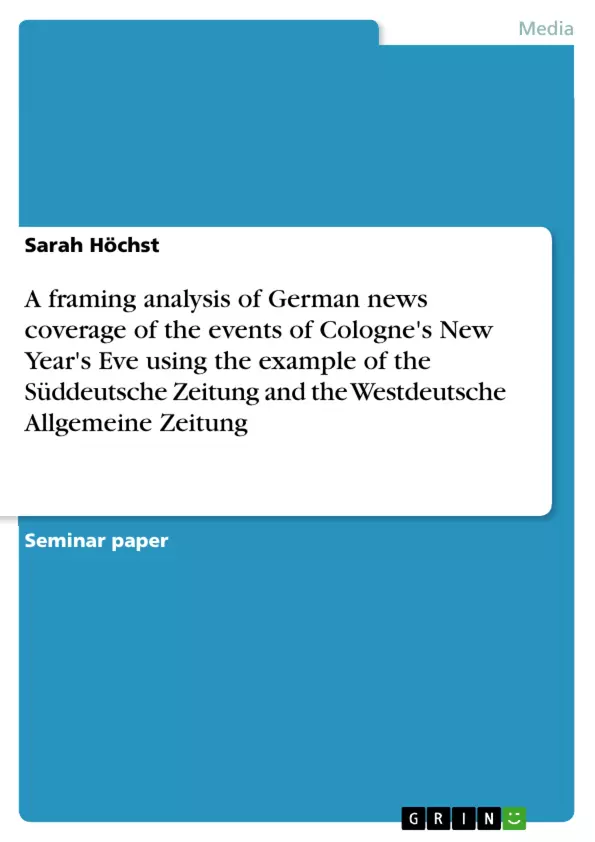The aim of the present scientific work is to answer the following key question: How can the frames of German news reporting on the events of New Year's Eve in Cologne be assessed using the example of the Süddeutsche Zeitung and the Westdeutsche Allgemeine Zeitung, how do the frames develop in the respective medium, how do they differ the media frames of the daily newspapers from each other and what effects do they achieve on the recipient level?
Since frames have great methodological potential, but are also very controversial, I will first define the framing tradition and the frame concept in the theoretical part of this final thesis. For this I will primarily use selected literature from Minsky, Konerding, Entman and Scheufele. After that, I will show different types of frames and discuss their possible effects on the recipient level. With the help of this theoretical basis, I can then use the frame concept as an analytical approach.
Three copies each of the Süddeutsche Zeitung and the Westdeutsche Allgemeine Zeitung are used as research instruments. Finally, in a last step, I will make a final assessment of the analysis results including the outlook.
Inhaltsverzeichnis (Table of Contents)
- Introductory
- Framing Theory
- Definitions of terms
- Distinguishing frames
- Framing effects
- Framing of news coverage of the events of Cologne's New Year's Eve
- Framing of the Süddeutsche Zeitung
- Framing of the Westdeutsche Allgemeine Zeitung
- Development and comparison of framings
- Final analysis of the analysis results and outlook
Zielsetzung und Themenschwerpunkte (Objectives and Key Themes)
This term paper aims to analyze the framing of German news coverage of the events of Cologne's New Year's Eve using the example of the Süddeutsche Zeitung and the Westdeutsche Allgemeine Zeitung. It investigates how the frames develop in the respective media, if the media frames of the daily newspapers differ from each other, and what effects they achieve at the recipient level.
- Framing theory and its application in analyzing media content
- Comparison of framing strategies used by the Süddeutsche Zeitung and the Westdeutsche Allgemeine Zeitung
- Potential effects of framing on audience perception and understanding
- Development and comparison of frames across different media outlets
- The influence of framing on the reception and interpretation of news events
Zusammenfassung der Kapitel (Chapter Summaries)
- Introductory: This chapter provides an overview of the research topic and its relevance in the context of media studies. It introduces the framing perspective as a modern methodology for analyzing media content and its impact on audiences. The chapter outlines the main research question and the specific approach used to answer it, focusing on the analysis of the Süddeutsche Zeitung and the Westdeutsche Allgemeine Zeitung.
- Framing Theory: This chapter presents a theoretical framework for understanding framing, defining key terms and distinguishing different types of frames. It discusses the potential effects of framing on audiences, including influencing their perceptions, attitudes, and behavior. This chapter serves as the theoretical foundation for the subsequent analysis.
- Framing of news coverage of the events of Cologne's New Year's Eve: This chapter delves into the analysis of the chosen news sources, focusing on identifying and comparing the framing strategies employed by the Süddeutsche Zeitung and the Westdeutsche Allgemeine Zeitung. It examines how each newspaper frames the events of Cologne's New Year's Eve and explores the potential implications of these framings for audiences.
Schlüsselwörter (Keywords)
The key terms and focus topics of this term paper include: framing theory, media analysis, news coverage, framing effects, audience reception, Süddeutsche Zeitung, Westdeutsche Allgemeine Zeitung, Cologne's New Year's Eve events, media framing strategies, and the influence of framing on public opinion.
- Quote paper
- Sarah Höchst (Author), 2016, A framing analysis of German news coverage of the events of Cologne's New Year's Eve using the example of the Süddeutsche Zeitung and the Westdeutsche Allgemeine Zeitung, Munich, GRIN Verlag, https://www.grin.com/document/1243798



